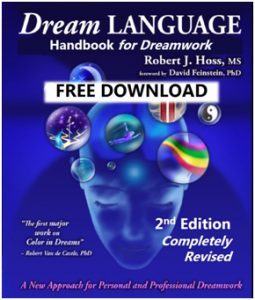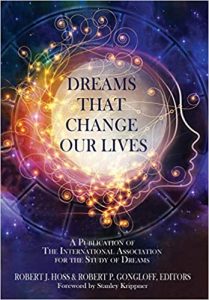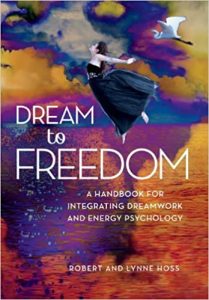Index
- Dream To Freedom Protocol Robert J Hoss M.S., Lynne M Hoss, M.A., CHEP
- Dream to Freedom Worksheet
- Dreaming and its Relationship to Energy Psychology by Robert J Hoss, M.S. and Lynne Hoss, M.A., CEHP presented at the 12th Annual International Energy Psychology Conference, June 4-6, 2010 San Diego California
- The Dream to Freedom Technique, a Methodology for Integrating the Complementary Therapies of Energy Psychology and Dreamwork Robert J. Hoss and Lynne M. Hoss, DreamScience Foundation, Cave Creek, AZ
Introduction
Lynne Hoss MA and Bob Hoss MS regularly provide group training and presentations on the Dream To FreedomTM Technique for therapists as well as those who wish to use the technique for self-help. Please contact bob@dreamscience.org for information. Also visit www.eft4dreams.com for more information on using EFT with dreams. To learn more about Energy Psychology methods and research, go to http://www.eftuniverse.com or www.EnergyPsychEd.com where you will find books, home study programs and other resources including free information about the field of Energy Psychol
Dream to Freedom
In this section I will discuss some of the psychological principles involved in that encounter and resolution process, from the viewpoint of some of the great psychologists and luminaries who have pioneered contemporary dream theory and dreamwork. The Nature of Dream Imagery is developed from the theories and practices of Jung, Perls, Hartmann and other great thinkers and research into the significance of color in “painting or dreams with emotion.” Finally individual and group dreamwork principles and ethics as well a Transformative Dreamwork protocol will be presented which integrates the practices of multiple proven approaches into a 3 part protocol which involves exploring: the associations within the narrative, underlying emotions within imagery and how the dream attempts resolution (a final closure and action phase).
Dream To Freedom Protocol
Robert J Hoss M.S., Lynne M Hoss, M.A., CHEP
The healing process often begins with addressing the symptoms of what might be a deeper issue, and peeling away at emotional layers until the core issue surfaces. By integrating Energy Psychology (EP) with dreamwork, it is possible to begin the energy healing at a deeper level. Dreams focus on unresolved emotional events of the day as related to deeper emotional conflicts which may lie within the psyche. Dreamwork can therefore quickly bring to consciousness an issue that a person is dealing with on an unconscious level as well as provide cues to the natural restoral process taking place. On the other hand, dreamwork alone – in the absence of other therapies – is not necessarily designed to reduce the emotional stress, or the barriers to healing, as disturbing memories surface. EP in turn complements dreamwork by providing a method for reducing the stress and emotional barriers to healing, once an issue is identified. Integrating the two disciplines into a therapeutic protocol, provides a healing method that is useful in a therapeutic setting or for self-help. We call this protocol, the Dream To Freedom™ technique (DTF). DTF has been shown to work well with traumatic memories, phobias or unresolved emotional conflicts and anxieties, particularly in cases where it is difficult to identify the underlying cause with dialog alone.
Design of the Protocol
The creation of such a protocol depended on combining a solid, well-established, and fairly rapid dreamworking approach, designed for revealing underlying emotional issues, with a solid, well established and fairly rapid EP technique which reduces anxiety, stress and the fear response. The combination of Gestalt role-play and the Emotional Freedom Technique (EFT or “tapping”) was chosen. There are three parts to the DTF protocol and worksheet, the details of which can be found in the Dream To Freedom handbook: 1) Part #1 explores the dream using a Gestalt-based approach for discovering the unconscious emotional issues the dream is dealing with; 2) in Part #2, we apply energy work, specifically EFT in order to reduce the anxiety surrounding the issue which stands in the way of progress; 3) in Part #3, after the emotional barriers are reduced, the dream is explored for cues as to how the unconscious was attempting to resolve the problem, as a natural aid in defining how best to progress beyond the situation.
Part #1 – Dreamwork/Issue Identification:
Ever since Freud revealed dreams to be the “royal road to the unconscious” many psychologists have augmented their therapies by exploring their client’s dreams in some fashion to understand the inner emotional issues that they are struggling with. Carl Jung, the founder of Analytical Psychology, was one of the first to recognize that “dreams reveal the unconscious aspect of a conscious event” whereby the unconscious meaning (the deeper emotional impact of an event) is expressed as a ‘symbol’ or picture language. Even most recently, researcher Ernest Hartmann stated that dreams “picture the emotional state of the dreamer.” Fritz Perls, founder of Gestalt Therapy, developed a method of role-play (giving your dream a ‘voice’) for revealing those emotions. We chose this approach because of its rapid targeting of the core emotional issues the dream is dealing with, since we wanted a session to be devoted to the healing, not overburdened with a lengthy interpretation of a dream or approaches that trigger only surface associations. We designed a simple 6 statement scripted role-play to guide the dreamer through the process. Understanding the deeper emotional issues involved, also increasing the effectiveness of energy psychology methods such as EFT.
Part #2 – EFT (“tapping”):
A solid, well established and fairly rapid therapeutic technique was also required, one which works directly on the limbic system to reduce anxiety, stress and the fear response. EFT provides such a tool, due to its simplicity and the wealth of efficacy research which has demonstrated its effectiveness with anxiety based conditions from phobias to PTSD. EFT works by bringing the disturbing emotional memory to mind, while stimulating (tapping on) acupuncture points (herein called acupressure points) for the purpose of providing a calming sensation in the presence of the memory, thus reversing the emotional associations and reaction to that memory. The mechanisms are still unclear, however, it is thought to send calming chemicals to the limbic region of the brain so as to change the memory associations from alarm to calm or neutral. This is supported in theory by studies which show the direct effect on the limbic system when acupuncture points are stimulated. It complements dreamwork by providing a method for reducing stress from emotional memories surfaced by the dream thus reducing the emotional barriers to healing.
Part #3 – Closure:
Once the emotional barriers are reduced, it is an opportune time to return to the dream for possible clues to help the dreamer progress beyond the situation. There is a lot of resolution activity taking place in dreams which can help guide this process. Jung stated that the general function of dreams is to “restore psychological balance by producing dream material that re-establishes psychic equilibrium” and that dreams have a “transcendent function” which operates by “compensating” or correcting for misconceptions that stand in our way, such that we can transition from one state of mind to another. Recent neurological studies during REM are also supportive of the emotional dampening and restorative activity of dreaming. By observing the compensating “dream material” that Jung spoke of and the influence of brain activity within the dream story, we gain bits of insight as to the approach our unconscious mind is taking in resolving a problem. Comparing the dream action as an analogy to the dreamer’s waking life situation, might provide a natural solution. Because these cues may not always be obvious, we augment this phase by engaging the subconscious in an imagining approach for completing the dream, with a method inspired by ‘imagery rehearsal treatment’.
The Dream to Freedom Protocol Summary
Part #1 – Dreamwork Discovery (Problem Identification)
Step #1 – Dream Report: re-enter the dream and describe it as if you are re-experiencing it, in the first person present tense.
Step #2 – Waking Life Situation: describe any emotionally important or impacting situations (positive or negative) in your life around the time of the dream.
Step #3 – Dream to Waking Life Analogies: note any obvious metaphors in your dream narrative (underline them) and describe any waking life situations or feelings that they bring to mind.
Step #4 – Gestalt role-play, giving the dream a voice:
Step # 4a – Pick a Dream Image to Explore: re-enter the dream and once immersed in it, pick something in the dream (a dream image X) that curiously draws your attention – no matter if it is a minor element or a dominant one.
Step #4b – Role-Play: close your eyes and brings that dream image (X) to your mind’s eye. Take a few deep breaths on each one bring it closer until you merge with it; or least can imagine how that thing X might answer each question below. Answer as X might answer them in the first person present tense.
1. What are you? Describe yourself and how you feel in that role. “I am …I feel….” (Note: if X is a known person, describe their personality)
2. As X what is your purpose or function? “My purpose is …”
3. What do you like most about being X? “What I like most is ….”
4. What do you dislike, about being X ? “What I dislike is….”
5. As X what do you fear the most; worst think that can happen? “What I fear most is….”
6. As X what do you desire the most? “What I desire most is….”
Step #4c – Relate to Waking Life: Read or play back each response but switch your perspective and listen to them as if it is YOU saying these things about a recent situation or feeling in YOUR life. Note and describe any connections and compare the feelings. In particular look at the ‘I like..” and “I dislike…” and “I fear” and “I desire” statements. Do they sound like an emotional conflict you are struggling with?
Step #5 – Exploring Color (Optional) Colors in the dream, particularly those that are intense or notable, are associated with our human emotional response to color at an unconscious level. (color questionnaire downloadable with DTF Worksheet; or from Home Page click the Dreams and Color menu button).
a) Color: What color(s) was the image you chose and/or what color(s) stood out in the dream?
b) Associations: Pick the closest color(s) in the Color Questionnaire and read each statement for that color. Which statement(s) most remind you of a recent feeling or situation? Describe the situation. Note: when there is a color pair, consider whether the 2 colors relate to 2 conflicting emotions.
Step #6 – Most Emotionally Charged Statement: Select the role-play statement in step #4, or statement from the color work in step #5, that you feel is most emotionally charged or relates to the most stressful memory. Summarize the situation and, if necessary, rephrase the statement to better relate to it.
Part #2 – “Tapping” for Stress Reduction
Step #7 – Specific Incident: At this point we are trying to recover the moment that the stress was encoded. We need to go a level deeper, so think about the feelings surrounding the situation in step #5 above, recall a specific incident when you felt that way and visualize the scene.
Step #8 – Initial Stress Rating (SUDS): rate the level of stress from 0-10 as you picture scene.
Step #9 – Affirmation: You are now going to create two phrases to be used to keep the emotional scene in mind and set intention, while tapping: an Affirmation used to “set up” the procedure and a shorter Reminder Phrase to use while tapping.
a) Affirmation: pairs the negative statement of the problem with a positive intention as follows – “even though I have this problem or feel this way (define the problem) – I chose to, or I know I can (add a positive intention).” We derive the negative from the feelings in step #7 and the positive intention from the positive “I like” or “desire” statements from the dreamwork in step #4.
b) Reminder Phrase: a few words from the negative part of the setup phrase to keep the memory in mind while tapping.
Step # 10 – Initial Tapping Round: The DTF protocol is not dependent on a specific tapping protocol however the standard we use is derived from ‘Clinical EFT’ (The EFT Mini-Manual (2nd ed). Church, 2012). See figures 1 and 2 below for tapping points.
Step # 10a – Preparation or “Setup” Exercise: tap on the SI-3 meridian point (known as the “karate chop” point) while saying the full Affirmation, three times.
Step # 10b – Initial Tapping Sequence: After the “setup” we recommend tapping on eight (8) acupressure points (typically about 7 to 10 times) while keeping the problem in mind by saying the shorter Reminder Phrase. Our standard points include: UB-2, GB-1, ST-2, GV-26, CV-24, KD-27, SP-21 ending with the “karate chop” point SI-3. After two rounds picture the scene again and re-rate the stress level.
Step # 11 – Subsequent Rounds: Assuming the stress level is not at zero, continue the tapping rounds until the stress level is near or at zero.
Step # 12 – Other Aspects: If after any round of tapping the level of stress remained or increased due to another memory, then stop and explore the feelings around that memory. Repeat Steps #7 through #11 with that new memory until the stress level around this aspect is reduced to near or at zero. Then go back to the original problem and check the stress level and if still high continue the tapping on that original memory.
Part #3 – Closure Protocol
Once the stressful reaction to the memory is reduced you should be able to think more clearly about the situation without reacting. This is an ideal time to return to the dream for guidance in creating an action plan for closure and moving forward.
Step #13 – Dream Guidance: The dream not only reflects the problem, but also attempts to resolve it in creative and natural ways, thus providing valuable clues as to how best to move forward. Close your eyes and re-enter the dream and briefly review it until the end. While in the dream try to recall if you experienced any of the following:
a) A Surprise: What was surprising and how did it differ from your expectation.
b) Guiding actions: Did you experience any guiding actions, including a discovery or insight, a guiding character, written or verbal words, or a lesson from the dream story. How did this alter your actions or thinking?
c) Reversal: Did you (or the character you identified with in the dream) have a reversal in attitude or direction? Describe the change.
c) Emotional Reinforcement: Did the dream end positively – or alternatively – with a demand or warning? What specific sequence of events brought it about?
Life Analogy: How might any of the above actions relate as an analogy to your waking life situation, in terms of guidance, a new perspective, or resolution.
Step #14 – Finishing the Dream: When the above activity is not apparent nor easily understood, or when the dream doesn’t seem to conclude, dream re-entry and spontaneous imaging (similar in nature to Imagery Rehearsal Treatment) can be used to create a new ending and a new metaphor analogous to a useful waking life solution.
a) Finish the Dream with a Positive Ending: Re-enter the dream at the end and focus on your feelings and what happened in the dream that brought you to this point. Then without thinking about it, just let the images flow, imagine continuing and finishing the dream from that point with a new positive ending.
b) Life Analogy: How might the new ending provide insight or be analogous to a waking life solution?
Step #15 – Closure: In order to actualize what has been learned, the insight which the dream or new ending presents as metaphor, needs to be converted to a concrete solution.
a) Define the Solution: Based on the insight from steps #13 and/or #14 define a specific solution that will allow you to move ahead in your waking life situation and avoid getting stuck again.
b) Check it Out: Before following any imagined solution, check it out to make sure it is healthy, practical and appropriate, or if it might leave you stuck again.
c) Next Steps:If the solution checks out positively, then define at least one specific next step or step(s) that you can take to bring it about.
d) “Token” Reminder Image: pick an image from the positive dream ending as a reminder of the solution; helpful in the event you find yourself confronted with a similar situation in the future.
Figure 1 Setup – Karate Chop Point with Full Affirmation

Figure 2 – Tapping Rounds with Short Reminder Phrase

1. EB or eyebrow point: at the start of the eyebrow where it joins the bridge of the nose (UB2)
2. SE or side of eye: on the outside edge of the eye socket (GB1)
3. UE or under eye: on the bony ridge of the eye socket under the pupil of the eye (ST2)
4. UN or under nose: under the center of the nose, 1/3 distance between the nose and the upper lip (GV26)
5. Chin: between the lower lip and the chin, in the center (CV24)
6. CB or collarbonepoints: located in a small depression under each collarbone on either side of the U-shaped groove at the top of the sternum (KD27)
7.UA or underarm: about four inches below the base of each armpit and about halfway between the front and back; for women, this is where a bra strap crosses, for men even with the nipple (SP21)
8. KC or Karate Chop point fleshy outer portion of the hand, upper middle about where the crease is (SI3)
*Gamut Point (for optional bridging procedure): back of either hand a half inch toward the wrist from the point between the knuckles and the base of the ring finger and little finger (TH3)
Case Example
(ref: Chapter 6 Dream To Freedom)
This subject which I will call Karen was struggling with an elusive anxiety response which was altering her life in a detrimental way. She was about to end a beautiful relationship, not due to any rational reason, but driven by a growing anxiety related to helping her boyfriend through a medical procedure. Tapping on the symptom may have been helpful, but without identifying and treating the underlying issue, the problem may have persisted. Fortunately Karen had a dream: “I am in the home I shared with my ex-husband, looking out over trees that contained black things. My mother is there and we are trying to decide whether they are birds or bats.” Although this dream seemed unrelated to Karen’s situation, as we will see it contained the very origin of her anxiety in explicit emotional detail.
We asked Karen to re-enter the dream and look for something in the dream scene that attracts her attention, curiously draws her to it. She was drawn to “a lone birds nest” in the tree. We took her into the birds nest and once there, asked the bird’s nest to speak – guiding her with the six scripted statements. Imagining herself as the bird’s nest she stated, “I am a lone bird’s nest, my purpose is to be warm, and enveloping, and to provide a safe landing spot;” and “my desire is to be there and strong when needed” – an apt description of how Karen’s saw her role in helping her boyfriend through the procedure. We then explored the opposite side of the conflict asking the bird’s nest what it disliked and feared. The bird’s nest said, “I dislike getting crapped and fear getting blown out of the tree!” It is apparent that this is not just a “bird’s nest” speaking, but the Karen’s own unconscious expression of the conflict – and the fear that created it.
We then asked Karen, to recall a specific incident where she felt she was ‘getting crapped on and blown out of the tree’?” She stated, “The moment I decided to divorce my ‘ex’. I had gone all out to help him and he showed up two-hours late and began yelling at me for not having done enough.” This was the moment when the stress reaction was encoded along with a decision to avoiding this vulnerability in future relationships – a decision which had now become dysfunctional. Given a 1 to 10 scale she stated that her stress was at “12” when picturing the scene! It was time to apply EFT. We began by using the words from her role-play to create the affirmation. “Even though I feel taken for granted, I choose to be there and be strong.” We used this and the reminder phrase taken for granted for the “setup” exercise and subsequent tapping rounds. After four rounds of tapping her stress level reduced to zero. Although she could now recall the traumatic moment without the emotional reaction, the work was not done. The decision she made at that moment, about herself and her relationships required some adjustment so that she would not fall into the same pattern again. We returned the dream for clues. The dream had guided Karen to an important decision point related to identity; deciding whether that aspect of her personality represented by the black things is “birds or bats.” This metaphor appeared to reflect her own conflicted identity regarding her role in relationships. In order to sort out the metaphor we engaged her in a visioning exercise asking her to “spontaneously let the images flow and finish the dream with a new positive ending.” What came forth was, “I fly away with the bats!” In sorting out the personal associations with this new metaphor she said, “Bats, like birds are free, but unlike birds are helpful and come home to the cave at night. I can be like the bat, be there, be helpful and still be me (free)!” Reflecting on her next steps she stated, “I will tell my boyfriend today that I have decided to stay in the relationship.” As it turns out her boyfriend happened to walk into the room just at this moment when the session ended. She went up to him and embraced and kissed him.






